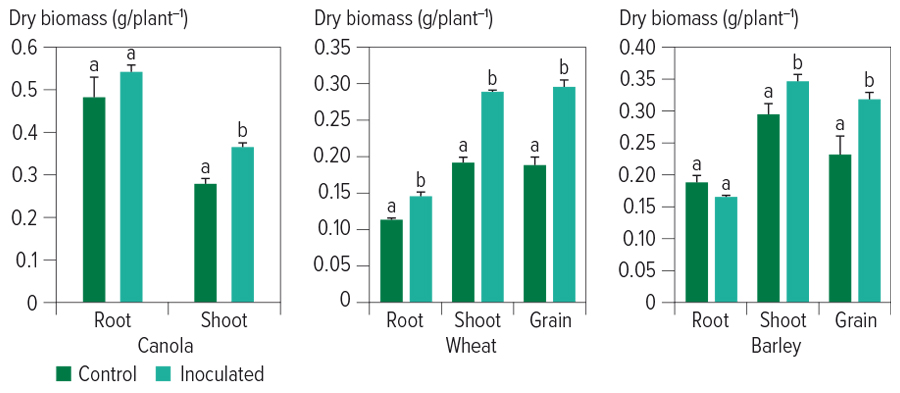Key Message
- The native fungus Austroboletus occidentalis may have potential as a biofertiliser significantly increasing shoot biomass in wheat, barley and canola when soil is inoculated with the fungus.
Fungi play a vital role in soil nutrient cycling, making nutrients such as phosphorus and nitrogen more available for plants. A special group of these fungi, known as mycorrhizal fungi, live in mutually beneficial relationships with plants and present an opportunity to be harnessed as living sources of biofertiliser for grain crops.
With GRDC investment, research at the University of Western Australia is investigating the biofertiliser potential of a native symbiotic fungus (Austroboletus occidentalis). This fungus has co-evolved with native plants in Jarrah forests in WA, providing growth and nutritional benefits to host plants by releasing nutrients in the soil and without forming mycorrhizal structures in roots.
Glasshouse experiments have shown to markedly improve plant growth and nutrition, and induce tolerance in host plants to environmental stresses such as drought. The challenge is to quantify the beneficial responses in crops and to harness this hidden fungal resource for growers’ advantage.
Controlled experiments
Controlled-environment experiments allow the investigation of plant- microorganism interactions in a managed way to provide scientifically valid results. Such experiments undertaken with A. occidentalis have demonstrated the growth and nutritional benefits, in particular phosphorus and nitrogen, of this native fungus in wheat, barley and canola grown in a low-nutrient sandy soil (Figure 1).
On completion of the trials, the soil inoculated with the fungus had lower pH compared to the control due to fungal activities (for example, exudation of organic acid anions), leading to greater nutrient availability, especially phosphorus, to crops.
Soil inoculated with this native fungus did not affect root colonisation by indigenous arbuscular mycorrhizal fungi in wheat and barley, indicating a compatibility between the native fungus and arbuscular mycorrhizal fungi. This means mycorrhizal crops can obtain benefits simultaneously from both fungal types.
While canola is non-mycorrhizal – that is, unable to draw benefits from arbuscular mycorrhizal fungi – it can still benefit from the fungus, as indicated by the shoot yield improvement in Figure 1.
Indeed, a previous glasshouse experiment demonstrated the fungus significantly increased canola shoot biomass and grain yield (by 20 per cent) in a field soil containing a high level of phosphorus (46 milligrams of phosphorus per kilogram, Colwell).
In vitro examination of A. occidentalis nutrient cycling abilities, using Petri dishes, showed it solubilised three water-insoluble – and therefore plant-unavailable –phosphorus forms. It was able to solubilise calcium phosphate, iron phosphate and aluminium phosphate via exudation of organic acid anions, which is considered a possible mechanism leading to enhanced soil phosphorus availability to crops.
Further controlled-environment trials are underway, characterising the benefits of the fungus to the three major grain crops in two different soil types under different soil phosphorus levels.
Figure 1: Biomass responses to the novel fungal symbiont in three major grain crops grown in a low-nutrient soil. Bars with different letters are significantly different (p≤0.05). Error bars indicate variability assessed by standard errors (four replicates).

Source: UWA
Future field trials
Trials planned for 2021 will characterise the extent of the crop benefits of the novel biofertiliser under field conditions. In particular, researchers will focus on its ability to enhance crop nutrition, particularly phosphorus and nitrogen, and stress tolerance, principally drought.
While it is early days yet, this work indicates the potential to effectively harness soil biota to reduce fertiliser inputs in cropping systems.
More information: Dr Khalil Kariman, khalil.kariman@uwa.edu.au, 08 6488 1508

























































